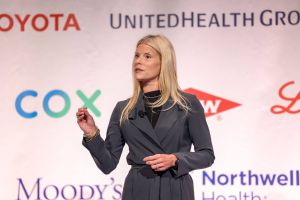(Originally published by Healthcare Finance)
Humana and Oak Street Health in Chicago have partnered on a model for value-based primary care that serves Medicare and dually-eligible beneficiaries.
By all accounts from the chief medical officers from both Humana and Oak Street Health, the model that began on the west side of Chicago is successful on all the metrics that matter, like lowering hospital admission rates by 45 percent.
Since it began three years ago, the Oak Street model has expanded to 19 locations in the Midwest, according to co-founder and Chief Medical Officer Griffin Myers, MD.
“Our population is just shy of 25,000 patients,” Myers said. “About half are dually-eligible.”
Humana provides the claims data and analytics so that, for instance, after the doctor writes a prescription, Oak Street gets the feedback on whether that prescription was filled.
“In this new value world, the payer is no longer the enemy,” said Roy Beveridge, MD, chief medical officer for Humana. “The payer is supporting the practice in its critical mission.”
Myers indicated he’s not worried about how potential new healthcare policies under a Trump administration would affect the PCP value-based model.
“Low on my list of concerns is how policy affects (this),” Griffin said. “When we first started, it was regulatory this and regulatory that. If we are the best, highest quality place for patients to get primary care, we will always be in place.”
Griffin is a former emergency room doctor who said he founded the practice because he was tired of seeing the same patients over and over again.
“It was low income older adults with chronic disease,” he said.
The patients weren’t managing their conditions, he said, because they weren’t seeing a primary care doctor.
“The reason you end up in the ED is always because of a failure in primary care,” he said. “We started knowing we could never provide care in a fee-for-servicemodel because the patients couldn’t afford it.”
Oak Street has a team of six doctors and nurses for about 400 to 600 patients, who are able to spend more time with a patient than on a fee-for-service model. Physicians do no data entry.
Getting there wasn’t easy.
“It is insanely hard,” Myers said. “You look at the degree of expertise and capital required to build an independent value-based practice. There’s folks who just want to provide the front-end of care. An average PCP has 2,500 patients.”
Beveridge and Griffin advise providers wanting to start a similar practice to jump in, rather than being split in the fee-for-service and value-based worlds.
“It’s harder for entities to have a foot in both worlds,” Beveridge said.
The risk-based arrangement creates meaningful savings, Myers said. Humana reported 20 percent lower costs for members treated by providers in value-basedreimbursement settings vs. traditional Medicare Advantage settings.
Oak Street has a full value-based arrangement with Humana for their Medicare Advantage and dual-eligible patients.
“We take a sick population of patients and achieve measurably better outcomes at measurably lower costs,” Myers said. “That’s our business model.”
Humana said it has more than 900 value-based relationships with close to 50,000 physicians in 43 states and Puerto Rico.
Approximately 63 percent of Humana individual Medicare Advantage members are affiliated with primary care physicians who are participating in value-based relationships.
The insurer announced earlier this year that it paid $93.6 million to 4,465 providers who participated in a rewards program for value-based care.


















